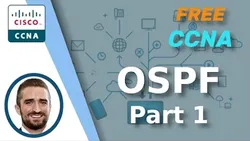
Free CCNA OSPF Part 1 Day 26 CCNA 200-301 Complete Course 
This course covers the basics of OSPF, a link state routing protocol. It reviews the types of dynamic routing protocols and how link state protocols work. It then introduces OSPF, including LSA flooding, the basic process, and OSPF areas and rules. Finally, it covers basic OSPF configuration. ▼
ADVERTISEMENT
Course Feature
![]() Cost:
Cost:
Free
![]() Provider:
Provider:
Youtube
![]() Certificate:
Certificate:
Paid Certification
![]() Language:
Language:
English
![]() Start Date:
Start Date:
On-Demand
Course Overview
❗The content presented here is sourced directly from Youtube platform. For comprehensive course details, including enrollment information, simply click on the 'Go to class' link on our website.
Updated in [February 21st, 2023]
Introduction.
Things we'll cover.
Review - Types of Dynamic Routing Protocols.
Review - How Link State Protocols work.
OSPF intro.
LSA Flooding.
Basic Process of OSPF.
OSPF Areas.
OSPF Area Rules.
Basic OSPF Configuration.
passive-interface command.
advertise a default route into OSPF.
show ip protocols.
Things we covered.
Quiz 1.
Quiz 2.
Quiz 3.
Quiz 4.
Quiz 5.
Boson ExSim.
(Please note that we obtained the following content based on information that users may want to know, such as skills, applicable scenarios, future development, etc., combined with AI tools, and have been manually reviewed)
This course provides an overview of Open Shortest Path First (OSPF) routing protocol. It begins with a review of the types of dynamic routing protocols and how link state protocols work. It then covers the introduction to OSPF, LSA flooding, the basic process of OSPF, OSPF areas, OSPF area rules, basic OSPF configuration, the passive-interface command, and how to advertise a default route into OSPF. The course also includes five quizzes and a Boson ExSim. Upon completion of this course, students will have a better understanding of OSPF and how to configure it.
[Applications]
After completing this course, students should be able to apply their knowledge of OSPF to configure and troubleshoot OSPF networks. They should also be able to identify the different types of OSPF areas and understand the rules for configuring them. Additionally, they should be able to use the passive-interface command and advertise a default route into OSPF. Finally, they should be able to use the show ip protocols command to verify their OSPF configuration.
[Career Paths]
1. Network Engineer: Network engineers are responsible for designing, implementing, and maintaining computer networks. They must be knowledgeable in a variety of technologies, including routing protocols, switching, and security. Network engineers must also be able to troubleshoot network issues and provide technical support. Developing trends in this field include the use of automation and artificial intelligence to manage networks more efficiently.
2. Network Administrator: Network administrators are responsible for the day-to-day operations of a network. They must be able to configure and troubleshoot network devices, as well as monitor network performance. Developing trends in this field include the use of cloud-based solutions to manage networks more effectively.
3. Network Security Analyst: Network security analysts are responsible for protecting networks from cyber threats. They must be knowledgeable in a variety of security technologies, including firewalls, intrusion detection systems, and encryption. Developing trends in this field include the use of machine learning and artificial intelligence to detect and respond to cyber threats more quickly.
4. Network Architect: Network architects are responsible for designing and implementing large-scale networks. They must be knowledgeable in a variety of technologies, including routing protocols, switching, and security. Developing trends in this field include the use of software-defined networking (SDN) to create more flexible and scalable networks.
[Education Paths]
1. Bachelor of Science in Computer Science: This degree path focuses on the fundamentals of computer science, such as programming, software engineering, and computer architecture. It also covers topics such as artificial intelligence, machine learning, and data science. This degree path is becoming increasingly popular as technology advances and more businesses rely on computer systems.
2. Bachelor of Science in Network Engineering: This degree path focuses on the design, implementation, and maintenance of computer networks. It covers topics such as network security, routing protocols, and network topologies. This degree path is becoming increasingly important as businesses rely on secure and reliable networks to conduct their operations.
3. Master of Science in Cybersecurity: This degree path focuses on the security of computer systems and networks. It covers topics such as cryptography, malware analysis, and digital forensics. This degree path is becoming increasingly important as businesses need to protect their data and systems from malicious actors.
4. Master of Science in Data Science: This degree path focuses on the analysis and interpretation of large datasets. It covers topics such as data mining, machine learning, and predictive analytics. This degree path is becoming increasingly popular as businesses need to make sense of the vast amounts of data they collect.
Course Provider

Provider Youtube's Stats at AZClass
Discussion and Reviews
0.0 (Based on 0 reviews)
Explore Similar Online Courses

Time Management for Supervisors

Faster 3d Printers Bowden vs Direct Extruder Creality Ender 3 v2 vs Ender 5

Python for Informatics: Exploring Information

Social Network Analysis

Introduction to Systematic Review and Meta-Analysis

The Analytics Edge

DCO042 - Python For Informatics

Causal Diagrams: Draw Your Assumptions Before Your Conclusions

Whole genome sequencing of bacterial genomes - tools and applications

CCNA (Cisco Certified Network Associate) Course

Packet Tracer labs for the CCNA 200-301 exam: Practical labs


Start your review of Free CCNA OSPF Part 1 Day 26 CCNA 200-301 Complete Course